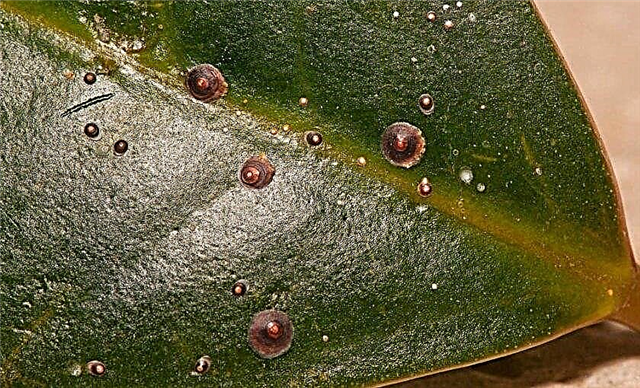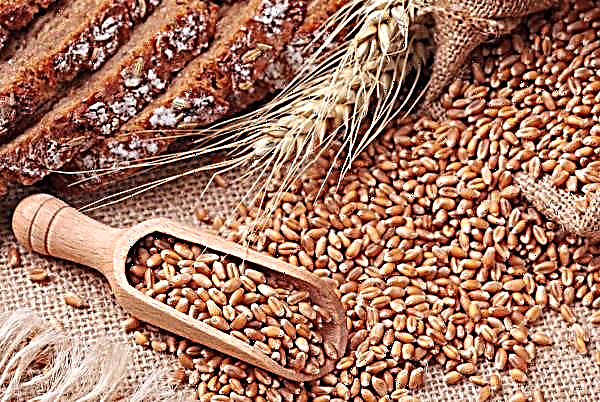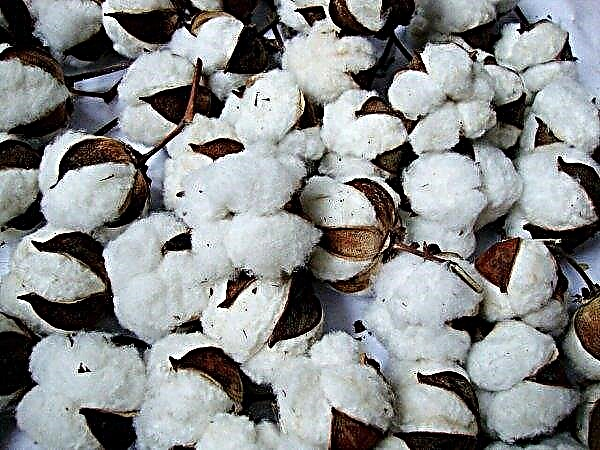Ficus Benjamin can become a decoration of any interior, if you follow the simple rules of caring for him. And knowing the methods of propagation of a flower at home, you can grow several from one plant. In this article, we will consider the basic rules and step-by-step instructions for reproduction of Benjamin ficus at home.
The basic rules for growing ficus Benjamin
Ficus refers to not too whimsical indoor plants to care for, but you should know a few subtleties of its cultivation. With proper care, the flower grows in a spreading bush, pleasing to the eye with its rich green leaves.
Did you know? In vivo cultivation, Benjamin's ficus can grow to a height of 30 m!
Here are the main rules for growing ficus Benjamin:
- A flower needs one permanent place; he does not like frequent permutations.
- The plant is best placed in partial shade or under diffuse lighting at a small distance from the window. Direct sunlight causes burns on the leaves.
- The soil should be fertile, loose, with an average level of acidity, drainage is mandatory.
- You can not leave the plant at temperatures below + 12 ° C, this will lead to its death. The optimum air temperature is +16 ... + 23 ° C.
- A flower can not be placed near heating appliances, since they very dry the air.
- Ficus can drop leaves on a draft, so it can not be placed in places with intersecting air currents.
- Regular airing has a beneficial effect on the growth and condition of flower leaves.
- Watering should be plentiful so that the soil in the pot never completely dries out. In summer, ficus is watered 2-3 times a week, and in winter - 1 time in 7 days.
- For watering the flower, settled water of room temperature is used; between waterings, you need to loosen the earth in a pot.
- Ficus needs regular spraying of leaves with water throughout the year, in the summer it is sometimes useful to put it in the shower.
- A room with a flower should have high humidity - about 80%.
- Ficus Benjamin needs to be fed with universal fertilizers every 7-10 days during the period of active growth (from May to September).
- It is recommended that the flower be transplanted into a larger pot every spring.
- An adult plant can be rejuvenated with cuttings. The basic rules of how to cut ficus are described below.

Breeding dates of ficus Benjamin
Ficus Benjamin is best amenable to reproduction from April to June. At this time, the roots and leaves of the flower grow most actively, and the young plant, obtained as a result of reproduction, will be able to gain strength and grow before the onset of autumn.
In order for the breeding process to complete successfully, the room with ficus must be warm and light. An important role is also played by proper watering of the plant and high humidity.Important! For the successful propagation of ficus Benjamin, the mother plant must be absolutely healthy.
Where to begin
In order for the propagation of the flower at home to be successful, you need to properly prepare the pot and soil for the sprouts.
The soil for plant propagation should consist of such components taken in the same proportions:
- vermiculitis;
- peat;
- sand.
To kill all the harmful microflora, the soil must be warmed up in the oven for half an hour before planting. Instead of an oven, you can use a steam bath. Before planting a young plant, the soil needs to be slightly moistened.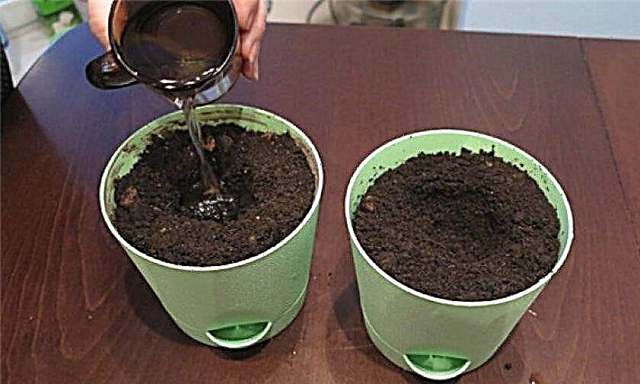
The capacity for a new young plant can be chosen at your discretion. To propagate the flower, the cuttings usually take a small pot with drainage holes at the bottom. When propagated by seeds, you can sow them in a regular wooden box filled with soil.
How to propagate Benjamin's ficus at home
In the wild, Benjamin's ficus propagates both vegetatively and by seed. Its shoots are easily rooted in the soil, forming new plants, and the seeds are carried by birds over long distances and also germinate. At home, Benjamin's ficus is propagated mainly by the vegetative method. Growing a new plant from seeds is a rare phenomenon, as it requires some experience and effort. Consider the main methods of propagating Benjamin's ficus at home.
At home, Benjamin's ficus is propagated mainly by the vegetative method. Growing a new plant from seeds is a rare phenomenon, as it requires some experience and effort. Consider the main methods of propagating Benjamin's ficus at home.
Cuttings
Propagation of ficus by cuttings is used most often. This method guarantees a positive result and even the beginner grower can do it. Cuttings should be green, but solid. Young green shoots are poorly rooted and prone to decay. Root cuttings can be in water or wet sand.
Did you know? On the island of Sri Lanka, the Ficus grows in the Royal Botanic Gardens, which is about 150 years old. Its crown resembles a tortoise shell in appearance.
Consider a step-by-step instruction for propagating Benjamin ficus with cuttings rooted in water:
- Cut about 15 cm from the apical part of the stem from the plant so that 2–4 leaves remain on it. The cut must be done obliquely using a sharpened knife.
- To wash the place of cut from the juice, you need to put the cuttings in a container with warm water. At the same time, its lower leaves should not get wet. The water in the bank must be periodically changed to fresh.
- When the juice at the cutting site ceases to stand out, remove the cuttings from the water and dry them a little at room temperature for 2 hours.
- Activated carbon is added to the tank with clean water and place the dried cuttings in it. Coal will prevent the seedling from decaying.
- Place the container on a brightly lit window sill, but not in direct sunlight.
- Keep cuttings at a temperature of about + 25 ° C and humidity of about 80% for 2 weeks.
- When small roots about 2 cm long are formed on the cut of the stalk, you need to transplant the young plant into an individual pot.

Root cuttings cut from ficus can also be in the sand. To do this, perform the following actions:
- Cut the stalk with 2-3 leaves and thoroughly rinse the place of its cut with water so that the protruding juice does not prevent the formation of young roots.
- Dry the shank at room temperature, treat the place of cut with powdered charcoal.
- Place the handle in prepared soil so that the lower kidney is completely submerged in the ground.
- Cover the young plant with a glass jar to create increased moisture and better root formation.
- As the soil dries, moderate watering is carried out. Shelter should be removed periodically to prevent decay of the cuttings.
- For accelerated root growth, the ground in a pot with a handle can be heated using a heating pad.
- When after 3-4 weeks new leaves begin to appear on the cuttings, the shelter can be removed. This should be done gradually, leaving the young plant without shelter every day for a longer period of time.
- After several new leaves grow on the handle, it is transplanted into a permanent pot.
Important! When rooting the handle in water, use only dark-colored dishes. The glass transparent container transmits light well, which leads to the active propagation of microscopic algae in water.
Layering
In some cases, Benjamin's ficus poorly releases young shoots, but consists of a large number of lignified branches. In this case, the plant can be propagated by air layers.
Consider the step-by-step instructions for this method of propagation of a flower:
- Choose one of the lignified shoots and make a shallow annular cut of the bark on it.
- Treat the incision site with a root growth stimulator.
- Wrap the incision with moistened sphagnum and fix it on a branch with a plastic film, fixing it with tape.
- Keep the plant in a well-lit room with a temperature of about + 25 ° C until small roots form at the incision site.
- After the formation of roots 1-2 cm long, gently cut off the resulting young sprout and transplant into an individual pot.
- Carefully treat the cut site on the branch of the mother plant with powdered charcoal.
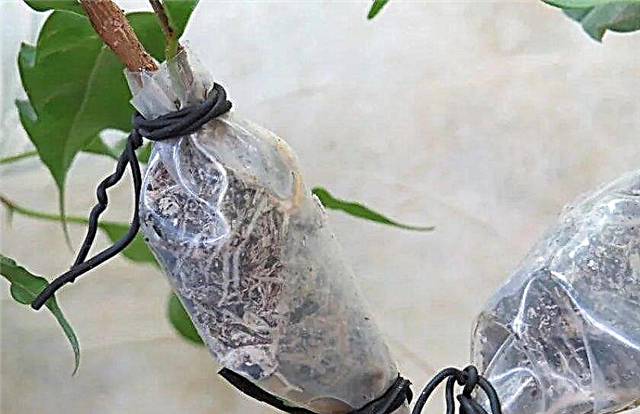
If you do not separate the seedling resulting from the shoot from the mother plant, its roots will gradually grow to the ground and take root in it, forming aerial roots.
Is it possible to grow seeds
At home, Benjamin's ficus is rarely grown from seeds, since this process is quite complex and time-consuming. Usually it is used only for the purpose of growing new varieties of flower. But if you have seeds, you can try to plant them and grow a new ficus on your own.
Consider a step-by-step instruction of actions:
- Soak the seeds in a solution of growth stimulant for 1-2 hours. To prevent the development of fungal diseases, seed is also sprayed with fungicides.
- Prepare a container with moist soil. It should be sufficiently loose and breathable.
- Deepen the seeds into the soil by 1-2 cm, lightly sprinkle them with earth.
- Cover the container with foil. Place the seeds in a well-lit place until the first seedlings appear. The air temperature should be +25 ... + 28 ° С.
- If necessary, moisten the topsoil with a light spray.
- When the seeds germinate - remove the film and keep the seedlings in partial shade so that they do not stretch too far up. As the soil dries, water it a little.
- When 2-3 leaves grow on the seedlings, the sprouts need to be transplanted into permanent individual pots.
Did you know? Milk juice released from the ficus stem consists of rubber for 15%, therefore it is actively used in industry.
Plant Care
Ficus Benjamin belongs to hardy indoor plants that are well rooted in the soil. But with improper care or in the conditions of an inappropriate microclimate, it can slow down growth and even die.
Consider a few recommendations for caring for a planted flower:
- Transplanting the sprout into an individual container, you need to take loose, nutrient-rich soil, which passes air and water well.
- At the bottom of the tank, it is necessary to lay the drainage to prevent stagnation of moisture around the roots.
- A pot with a young plant should be kept in a well-lit place so that its leaves grow evenly and do not stretch too much.
- It is not recommended to move the flower and allow temperature differences - this can trigger a drop of leaves.
- Water the flower should be moderate, as the earthen coma dries up, frequent spraying with water is useful.
- You can not put a young ficus on a draft - this will lead to the death of the flower.
- For good growth, the flower is fed with fertilizers every 14 days, while organic and mineral dressing can be alternated.
- After a year, the young plant needs to be transplanted into a larger pot.
Possible growing difficulties
If you deviate from the above recommendations for the care of Benjamin's ficus, the flower may suffer from diseases and pests. If you notice the problem in a timely manner and take measures to eliminate it, then curing the plant will not be difficult.
Important! The main causes of diseases and pests are improper irrigation of ficus and too dry air in the room.
Consider the main difficulties that may arise when growing a plant:
- Spider mite. Occurs when growing a flower in a dry and warm room. The leaves of the plant are covered with tiny black dots and a thin white cobweb, then begin to dry out. At the initial stage of the lesion, the ficus should be washed in the shower, washing off pests from the leaves. Then the flower is treated with insecticides and increase the level of humidity in the room.
- Shield. These insects have the appearance of small black or brown dots on the lower surface of the leaves of the plant. They cover the foliage with a sticky substance, as a result of which the leaves begin to lose color and fall off. Scabies appear when growing a flower in a hot room with dry air. To get rid of the pest, you need to wipe the leaves of the ficus with a concentrated soap solution. Then the flower is treated with insecticides.
- Mealybug. It covers ficus leaves with a white coating, on which insects themselves are visible, resembling small pieces of cotton wool. The pest multiplies well in dry air and leads to wilting of flower leaves. To remove insects from the leaves, they are wiped with a swab dipped in soapy water. Then the plant is treated with pesticides.
- Leaf fall. Many factors can cause this problem: low air humidity, drafts, improper watering, temperature changes, lack of lighting, or frequent flower movements. To eliminate this problem, you need to accurately determine its cause and make adjustments to the flower care mode. Usually after this, the ficus stops dropping foliage and begins to actively grow green mass.
- Root rot. It occurs with improper watering, hypothermia of the flower and in the absence of loosening of the soil surface in a flower pot. Manifested by withering and yellowing of leaves, which then darken and fall. To cure a flower, you need to remove it from the pot, inspect the roots and cut the damaged areas. Then the plant is transplanted into new soil and watered with an aqueous solution of fungicide.


